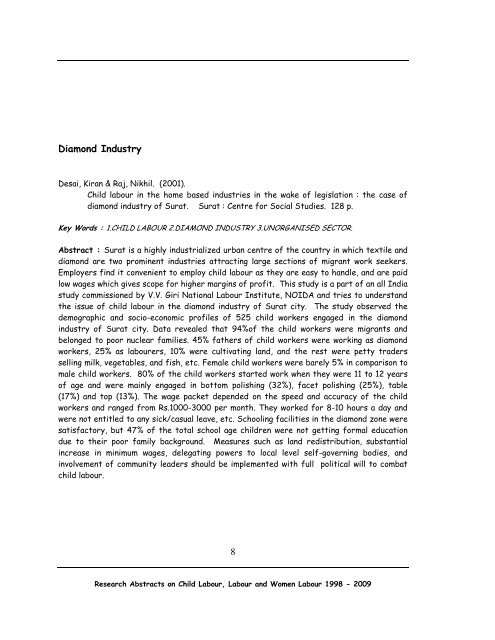Research Abstracts on Child Labour Women Labour - Nipccd
Research Abstracts on Child Labour Women Labour - Nipccd
Research Abstracts on Child Labour Women Labour - Nipccd
Create successful ePaper yourself
Turn your PDF publications into a flip-book with our unique Google optimized e-Paper software.
Diam<strong>on</strong>d Industry<br />
Desai, Kiran & Raj, Nikhil. (2001).<br />
<strong>Child</strong> labour in the home based industries in the wake of legislati<strong>on</strong> : the case of<br />
diam<strong>on</strong>d industry of Surat. Surat : Centre for Social Studies. 128 p.<br />
Key Words : 1.CHILD LABOUR 2.DIAMOND INDUSTRY 3.UNORGANISED SECTOR.<br />
Abstract : Surat is a highly industrialized urban centre of the country in which textile and<br />
diam<strong>on</strong>d are two prominent industries attracting large secti<strong>on</strong>s of migrant work seekers.<br />
Employers find it c<strong>on</strong>venient to employ child labour as they are easy to handle, and are paid<br />
low wages which gives scope for higher margins of profit. This study is a part of an all India<br />
study commissi<strong>on</strong>ed by V.V. Giri Nati<strong>on</strong>al <strong>Labour</strong> Institute, NOIDA and tries to understand<br />
the issue of child labour in the diam<strong>on</strong>d industry of Surat city. The study observed the<br />
demographic and socio-ec<strong>on</strong>omic profiles of 525 child workers engaged in the diam<strong>on</strong>d<br />
industry of Surat city. Data revealed that 94%of the child workers were migrants and<br />
bel<strong>on</strong>ged to poor nuclear families. 45% fathers of child workers were working as diam<strong>on</strong>d<br />
workers, 25% as labourers, 10% were cultivating land, and the rest were petty traders<br />
selling milk, vegetables, and fish, etc. Female child workers were barely 5% in comparis<strong>on</strong> to<br />
male child workers. 80% of the child workers started work when they were 11 to 12 years<br />
of age and were mainly engaged in bottom polishing (32%), facet polishing (25%), table<br />
(17%) and top (13%). The wage packet depended <strong>on</strong> the speed and accuracy of the child<br />
workers and ranged from Rs.1000-3000 per m<strong>on</strong>th. They worked for 8-10 hours a day and<br />
were not entitled to any sick/casual leave, etc. Schooling facilities in the diam<strong>on</strong>d z<strong>on</strong>e were<br />
satisfactory, but 47% of the total school age children were not getting formal educati<strong>on</strong><br />
due to their poor family background. Measures such as land redistributi<strong>on</strong>, substantial<br />
increase in minimum wages, delegating powers to local level self-governing bodies, and<br />
involvement of community leaders should be implemented with full political will to combat<br />
child labour.<br />
8<br />
<str<strong>on</strong>g>Research</str<strong>on</strong>g> <str<strong>on</strong>g>Abstracts</str<strong>on</strong>g> <strong>on</strong> <strong>Child</strong> <strong>Labour</strong>, <strong>Labour</strong> and <strong>Women</strong> <strong>Labour</strong> 1998 - 2009

















